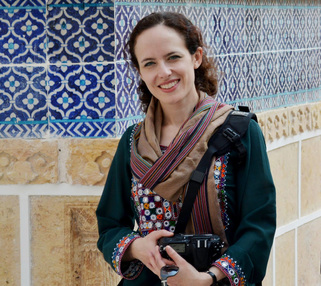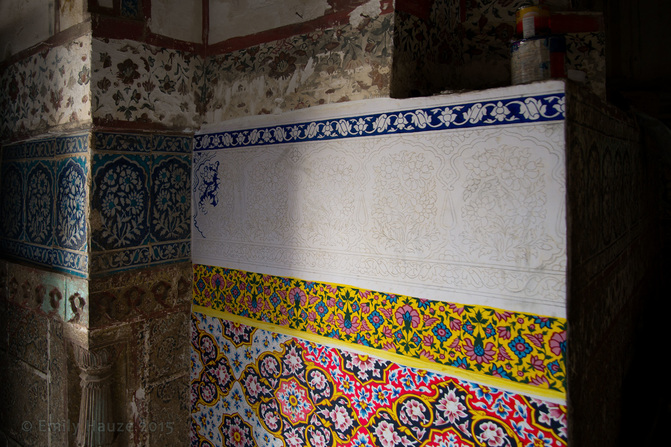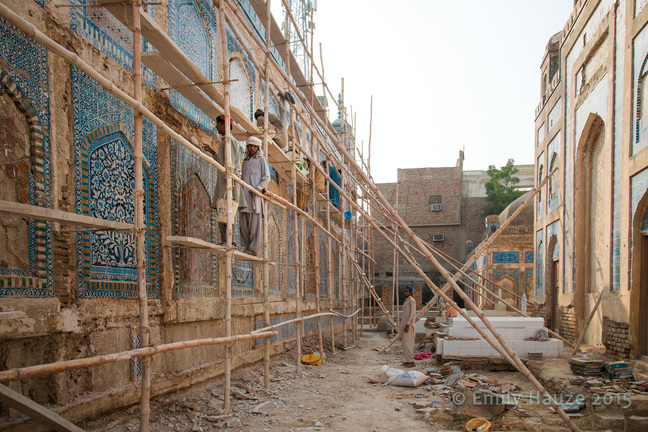|
Though general excitement prevented me from sleeping soundly for those few hours (see previous blog entry for context), I was very comfortable in the guest room of Inam’s house, which is an airy space with high ceilings and a door out onto a balcony. And the February breeze was warm and pleasant. When I had left the US from New York City, the winter had been at its most frigid, with a biting wind and temperatures significantly below freezing. Only now, as I write this blog post in early May, is the weather here in the US starting to rival that wonderful Hyderabad February. (Meanwhile my friends in Sindh are now all sweltering….sorry, dear ones.) When eventually I mustered the energy to get myself up, I heard a knock on the door. I was greeted by Inam’s two elder daughters, Priya and Aroma, who had brought me a glass of freshly squeezed orange juice on a small tray. I invited them in and they chatted with me while I drank it. I had not previously met either one of them, but, as so often happens in Sindh, I quickly began to feel that they were my own younger sisters or nieces. Both of these young women impressed me greatly, and are worthy of more comment, but if I get into that I might risk not ever reaching my intended destination of description, which is the Mir tombs. So, suffice it to say that Priya and Aroma and the juice they brought gave me just the energy I needed to start myself up again in this new time zone. While I rested, Inam had been making arrangements for our day--or perhaps the arrangements made themselves, as they always seem to do in Sindh, where friends appear out of the woodwork, and food always materializes in vast quantities too, and there is always some place to go and something to see and some music to be sung. (Of course it takes a lot of work to create such a hospitable environment, but to the guest it feels seamless and effortless, because it is done so gracefully.) Thus it was today also. Soon after I had gotten myself up, Inam’s friends started arriving to greet me and one another. This is a group of Inam’s colleagues from various fields, intellectuals in various subjects and trades, all roughly Inam’s age, which is to say about almost a generation older than myself. But a difference in age is immaterial among buddies -- which is what these gentlemen all became to me, and what I always call them as well, my dear buddies. Being in their company was easy and natural. And although I was often the only female in the room, they never caused me even the slightest unease. I was a welcome buddy among buddies, loved and respected as a member of the Sindhi family. And it was indeed a charming group that assembled there in Inam’s living room, each individual with his own stories, though I barely scratched the surface in my short time there. There was of course dear Naz Sahito, whom I had met during my previous trip--a television journalist and smiling, sunny personality whom I consider one of my core buddies. The others I was meeting for the first time, forming first impressions--the gentle and graceful Naseer Mirza, kind-hearted Irfan, the austere intellectual Naranjan, the mischievous Rafiq, the quiet Mohammed, levelheaded Ishtiaq, and several others, who, in various combinations, would be my traveling companions for the next two days and again when I returned to Hyderabad at the end of this trip. Groups of friends, at least in the vicinity of Inam, seem to have a certain natural cohesiveness. Rarely does a day go by, he told me, that these friends do not find time to see one another in some form or other.  Me at the Tombs. Photo by Ishtiaq. Me at the Tombs. Photo by Ishtiaq. Once we were all well fed on Sindhi fish and daal and lotus roots, the buddies dispersed, to be re-assembled again later. Only Ishtiaq Ansari remained with us for our first ventures into Hyderabad and its environs. Our first stops were actually in and around Jamshoro, a place well known to most Sindhis for its university. We went down to the Indus in the glare of the mid-afternoon sun and walked on its cracked shores, near groups of grazing buffaloes. And we visited the institute of Sindhology, passing through the thatched blue shadows of palm trees in its courtyard. Those places deserve more attention from me as well, and further visiting. But on this particular afternoon, I got only fleeting glimpses of them. Soon we were motoring back into the city, to the neighborhood of Hirabad, where we would find the tombs of the Talpur Mirs. And I will do my best to offer just a little bit of history here, in few words, for the uninitiated. “Talpur” is the name of the dynasty that reigned in Sindh from 1783 to 1843, while the word “Mir” (related to “emir”) indicates their position of power. Their principal emir at the time when they came to power, having defeated the previous Kalhora rulers, was Mir Fateh Ali Khan (Talpur). He chose Hyderabad as his seat of power and reigned from there with three of his brothers. Two other brothers were established in other cities of Sindh, namely Mirpurkhas and Khairpur. (On my previous trip, I had the unusual good fortune to meet a surviving prince of Khairpur’s Talpur dynasty--but that is a story for another day.) Mir Fateh Ali Khan ruled until his death in 1801, and then power passed to his brother Mir Ghulam Ali Khan, and then upon the latter’s death in 1811 to another brother, Mir Karam Ali Khan. It was for him that the tombs were built (beginning in 1812), and he lies buried there. The Talpurs continued to reign in Sindh, despite internal family rifts and other difficulties, until the British East India Company forced them out, defeating them at the Battle of Miani in 1843. Incidentally, that notorious battle was waged on February 17, the same day as my visit to the Tombs. So, the Mir Tombs only a little more than 200 years old -- which may not seem like much in archaeological time, but these tumultuous two centuries have worn heavily on the tombs, as they have on all of our Sindh. It has been a constant refrain of my travels in Sindh -- a lament for the disintegrating monuments of the province, with great wailing and gnashing of teeth concerning the lack of care that the government has given to the heritage sites of Sindh. Though beloved of the people of Sindh, who look to these places with great pride and interest, most historical sites in Sindh are indeed very minimally looked after. Even Moen-jo-Daro, whose ancient ruins are some of the world’s most significant, has fairly minimal oversight from a small staff. Other sites are completely unattended. The magnificent ramparts of Kot Digi, for example, stand without any of the usual trappings of historic tourist attractions. Its visitors enter through a spiked doorway that stands open in this otherwise impenetrable fortification, without encountering even as much resistance as would be offered by a free-will donation box. But the Mir Tombs are now an exception to that rule of neglect and decay. This is the particular project of our buddy Ishtiaq Ansari, who has been leading a team of workers and engineers to restore the site to its former glory. They began the restoration in April of 2012 and are currently in the last days of work, expecting to be complete before this very month is over (May 2015). I was fortunate enough to visit (on 17 February 2015) at a time when the work was still under way, so that I could see some of it unfolding before my eyes. And this was no slapdash bandaid repair job, of the kind that I am told many other “restored” sites have been been given. Ishtiaq and his team have approached the site with loving attention to all of its details -- and what intricate and ornate details they are.  Entrance to the tombs. Entrance to the tombs. I’m not sure whether I realized where we were going before we arrived at the site of the tombs -- having entrusted my schedule completely to Inam, I was simply enjoying being ferried about from place to place. But once we arrived, I realized that I was already quite familiar with this site, as seen through the eyes of my friend Jani Abro, whose novel I have been editing for the last several months. Jani himself is from Hyderabad (and a close friend of Inam’s, incidentally), though he has been living in the US, not so far from where I live, for the past couple of decades. And although I have promised not to give away any of his plot until after the novel gets published, I think it is safe to say that his descriptions of his homeland (not just Hyderabad but many parts of Sindh) are vivid and profoundly accurate. If I could have a rupee for every time I exclaimed “I know this already from Jani’s novel!!” during my travels in Sindh, I would be a rich woman. Well, maybe not, but at least I would have a few hundred rupees. And those Sindhi things that would cause me to invoke Jani’s name were not always specific places -- it might as easily be a gesture, or a tree, or a custom, or a greeting, or even a smell, which would prompt me to cry out, “it’s in Jani’s book!” But in this case it was indeed a place, because one of Jani’s protagonists walks across Hyderabad to these very tombs and observes them in detail, in the state of deep decay that was their reality until Ishtiaq and his team stepped in. So as I entered through the arched gateway, I realized I was already familiar with this place. But these were no longer the crumbling ruins of Jani’s book--although the unfinished corridors give attest to the authenticity of Jani’s descriptions. The undecorated parts of the walls are now a glistening and solid white, where once they were a crumbling orange. And the decorated parts--which are the majority--tiled and carved and painted, are fresh and crisp and bright, where previously they had looked almost as if their brilliant colors had been scrubbed out by some malicious titan wielding a block of steel wool. Just as interesting to me as the elegant structures, though, was the process of restoration itself, which was unfolding before me. As we entered and stood before the main facade, my eyes quickly drifted to the left, which at first resembled something like a quarry. But it wasn’t stones being excavated here -- instead it was filled with piles of earthenware tiles, many of them painted already, stacked up and ready to be paved into their proper places in the jigsaw puzzle of the mosaic. Each tile was being meticulously prepared to replace its historic predecessor, using identical designs and materials. Artisans had been brought in from the not-too-distant city of Hala, which is renowned in Sindh for the quality of its arts and crafts, as well as Nasarpur, where there is also a surviving tile center. There was a kiln here on the site for firing the new tiles, and each one of these thousands of little artworks was created and painted here by hand. The field of tiles-in-progress was something beautiful in itself, like a collection of especially elegant building blocks, colorful toys for some giant infant prince. Busy workmen peeped out at me from behind these painted stacks as I snapped photos in their direction.  Inside the tombs, other workmen were diligently engaged in the dusty work of mortars and plasters. In the shade offered by one of these interiors, sitting on the floor right next to the tombs themselves, were two workers wearing shawl-turbans and holding long sticks, obscured slightly to the eye by a white dust-cloud of their own making. They were using their sticks to beat chunks of charred chiroli (a gypsum-like material, I am told) into a smaller and more manageable chunks.  In a second tomb interior, another seated workman was grinding these smaller chunks of chiroli into a powder, which would in turn be mixed into a mortar. Another worker in this room was sitting with a pile of jute fibers laid out in front of him, which he was beating with a pair of sticks to thin them out, for use in a binding plaster. All of these, as was explained to me, are the traditional Sindhi building methods, which have been preserved over centuries. Some of these interiors also needed to be repainted. I recalled something about the fading frescoes inside the tombs from Jani’s novel. But now I could see them before my own eyes, and indeed, what little of the paint that time and entropy had left on the walls was faded and chipped and indistinct. But careful attention had been paid to those still-visible sections, and skilled eyes had plotted out exactly what needed to be reinstated on the walls. This also was being done entirely by hand, with small paintbrushes requiring extremely delicate control. It had been difficult, I was told, to find someone capable of the task, but ultimately they had found a young man from Hala who was gifted enough to be entrusted with the job. Some of the exterior facades, as I mentioned, had already been completed, but other walls were being tended to right at this time. Rustic-looking scaffoldings had been erected using wooden poles and platforms tied with rope, like some imaginary jungle treehouse. But it was not playtime for these workmen, who were hard at work, positioned on all different levels, laying tiles or smoothing plasters. Behind all this is a backdrop of a more modern urban vintage, as the city has grown up right around these tombs, not leaving a great deal of breathing space. Some people might gripe at the intrusion of modernity, with its grimy and uneven walls and reminders of industrialization, at the periphery of the tomb site, but I actually think it is an asset. Perhaps it is just my own fondness for cityscapes of all kinds, but I was charmed by the way the neighborhood seems to cuddle around the tombs in a kind of dusty embrace. I like the juxtaposition of the old and new, the layering of epochs one right on top of the other. I also would have liked for one of the tombs to be left in its state of ruin, to demonstrate to future visitors how immense the restoration project had been on the rest of it (and also because--I can’t help it--I just love ruins). But perhaps that would leave a sense of incompletion on the part of Ishtiaq and his team, who want to make sure that their work is done with excellence from start to finish.  Ishtiaq, as we drank tea. Ishtiaq, as we drank tea. It was a bright afternoon, pleasantly warm. It felt a full day had already passed, even though I had actually only been back in the country for about 14 hours at this point. I was eager for a rest. And, as he always seems to do, Inam was able to sense this, and had even prepared for it, or else Ishtiaq had, in this case. As we returned to the front courtyard after seeing all the tombs, a low table was waiting for us, with several chairs around it, already set with bottles of water and plates of cookies. And soon, as I have grown to expect, that magical tea once again appeared out of nowhere, brought to us on a tray by some servant or worker from Ishtiaq’s team. I hadn’t been away from Pakistan long, but I had already been missing this tea. And so once again a chapter ends with that sweet and strong hot tea of Sindh. And there are so many more stories still to tell in coming chapters -- I am not even sure which will come next. Perhaps the trip to Makli and Thatta that happened the day after this, or maybe the trip to Khairpur that I hinted at earlier in this episode; or else perhaps I will delve into a wonderful subject that I have been saving for some time, which is Sindhi music. We shall see. For now, wari milandaseen, Allah wahee. My photos from the Mir Tombs: a slideshow.
2050 Comments
|
Image at top left is a digital
portrait by Pakistani artist Imran Zaib, based on one of my own photographic self-portraits in Thari dress. AuthorCurious mind. Archives
September 2020
Categories |
emily s. hauze





 RSS Feed
RSS Feed
